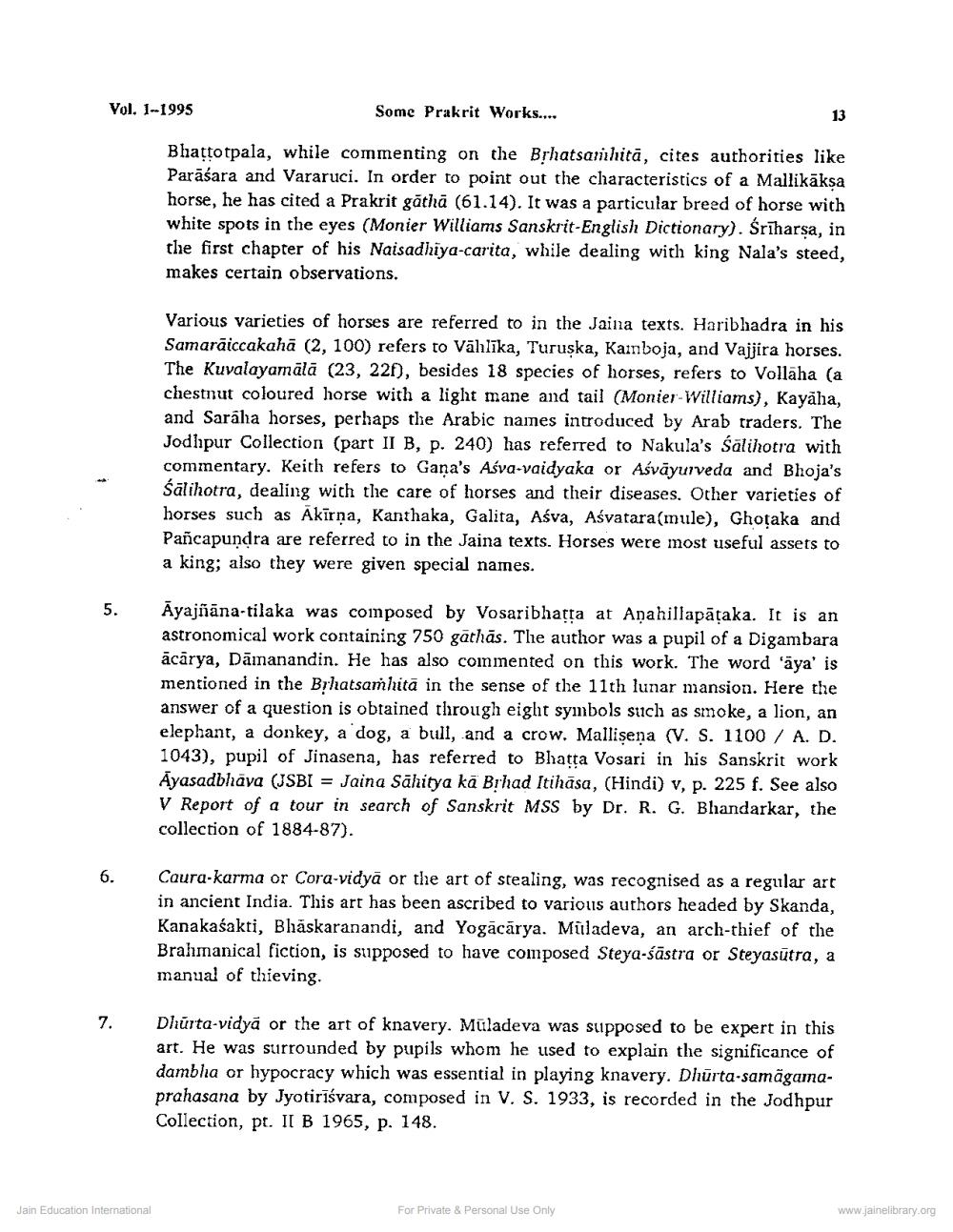Book Title: Some Prakrit Works on Non Religious Literature Author(s): Jagdishchandra Jain Publisher: Z_Nirgrantha_1_022701.pdf and Nirgrantha_2_022702.pdf and Nirgrantha_3_022703.pdf View full book textPage 3
________________ Vol. 1--1995 Some Prakrit Works.... Bhattotpala, while commenting on the Brhatsamhitā, cites authorities like Parāśara and Vararuci. In order to point out the characteristics of a Mallikāksa horse, he has cited a Prakrit găthā (61.14). It was a particular breed of horse with white spots in the eyes (Monier Williams Sanskrit-English Dictionary). Śrīharsa, in the first chapter of his Naisadhiya-carita, while dealing with king Nala's steed, makes certain observations. Various varieties of horses are referred to in the Jaina texts. Haribhadra in his Samarāiccakahā (2, 100) refers to Vāhlīka, Turuska, Kamboja, and Vajjira horses. The Kuvalayamālā (23, 221), besides 18 species of horses, refers to Vollāha (a chestnut coloured horse with a light mane and tail (Monier-Williams), Kayaha, and Saraha horses, perhaps the Arabic names introduced by Arab traders. The Jodhpur Collection (part II B, p. 240) has referred to Nakula's śālihotra with commentary. Keith refers to Gana's Aśva-vaidyaka or Aśvāyurveda and Bhoja's Śālihotra, dealing with the care of horses and their diseases. Other varieties of horses such as Akirņa, Kanthaka, Galita, Aśva, Aśvatara(mule), Ghotaka and Pancapundra are referred to in the Jaina texts. Horses were most useful assets to a king; also they were given special names. Āyajñāna-tilaka was composed by Vosaribhatta at Anahillapāțaka. It is an astronomical work containing 750 gathās. The author was a pupil of a Digambara ācārya, Dāmanandin. He has also commented on this work. The word 'aya' is mentioned in the Brhatsaṁhita in the sense of the 11th lunar mansion. Here the answer of a question is obtained through eight symbols such as smoke, a lion, an elephant, a donkey, a dog, a bull, and a crow. Mallisena (V. S. 1100 / A. D. 1043), pupil of Jinasena, has referred to Bhatta Vosari in his Sanskrit work Ayasadbhāya (JSBI = Jaina Sahitya kā Brhad stihāsa, (Hindi) v, p. 225 f. See also V Report of a tour in search of Sanskrit MSS by Dr. R. G. Bhandarkar, the collection of 1884-87). Caura-karma or Cora-vidyā or the art of stealing, was recognised as a regular art in ancient India. This art has been ascribed to various authors headed by Skanda, Kanakaśakti, Bhaskaranandi, and Yogācārya. Müladeva, an arch-thief of the Brahmanical fiction, is supposed to have composed Steya-śāstra or Steyasūtra, a manual of thieving. Dhurta-vidyā or the art of knavery. Müladeva was supposed to be expert in this art. He was surrounded by pupils whom he used to explain the significance of dambha or hypocracy which was essential in playing knavery. Dhurta-samāgamaprahasana by Jyotiriśvara, composed in V. S. 1933, is recorded in the Jodhpur Collection, pr. II B 1965, p. 148. Jain Education International For Private & Personal Use Only www.jainelibrary.orgPage Navigation
1 2 3 4 5 6 7 8 9 10
